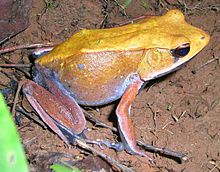Echte kikkers | of echte kikkers komen voor in de meeste landen behalve Antarctica
De Ranidae of echte kikkers komen voor in de meeste landen behalve Antarctica. De echte kikkers komen voor in Noord-Amerika, het noorden van Zuid-Amerika, Europa, Azië, Madagaskar, Afrika, Oost-Indië, Nieuw-Guinea en Australië. De brulkikker is de grootste echte kikker in Noord-Amerika. Gewoonlijk zijn echte kikkers gladde, vochtige kikkers met grote, krachtige poten en hebben ze zwemvliezen. De kleinste echte kikkers zijn de boskikkers (Rana sylvatica). De grootste is de goliathkikker (Conraua goliath). Echte kikkers zijn semi-aquatische kikkers. Ze leven in de buurt van water.

De tweekleurige kikker (Clinotarsus curtipes) is een van de vele "echte kikkers".
Subfamilies
Onder de Ranidae vallen de volgende onderfamilies. Sommige worden soms als aparte families behandeld:
- Ceratobatrachinae (Maleisië, Filippijnen, Borneo, Papoea-Nieuw-Guinea, Bismarck-archipel)
- Conrauinae (Afrika)
- Dicroglossinae
- Micrixalinae (India)
- Nyctibatrachinae (West-Ghats, India; Sri Lanka)
- Petropedetinae (Afrika)
- Ptychadeninae (voornamelijk Afrika)
- Raninae
- Ranixalinae (India)
Geslacht
- Afrana
- Allopaa Ohler & Dubois, 2006
- Amietia
- Amolops
- Anhydrophryne
- Arthroleptella
- Arthroleptiden
- Aubria
- Babina (soms opgenomen in Rana)
- Batrachylodes
- Cacosternum
- Ceratobatrachus
- Chaparana
- Chrysopaa Ohler & Dubois, 2006
- Clinotarsus Mivart 1869 (voorheen in Rana, omvat Nasirana)
- Conraua
- Dimorphognathus
- Discodeles
- Ericabatrachus
- Euphlyctis
- Fejervarya (voorheen in Rana, paraphyletisch)
- Fagayman
- Glandirana (vroeger in Rana)
- Hildebrandtia
- Hoplobatrachus
- Huia (polyfyletisch)
- Hylarana Tschudi 1838 (voorheen in Rana)
- Indirana
- Ingerana
- Lankanectes
- Lanzarana
- Limnonectes
- Meristogenys (hoort misschien thuis in Huia)
- Micrixalus
- Microbatrachella
- Minervarya
- Nannophrys
- Nanorana
- Natalobatrachus
- Nothophryne
- Nyctibatrachus
- Occidozyga
- Odorrana (voorheen in Rana)
- Paa
- Palmatorappia
- Pelophylax Fitzinger 1843 (voorheen in Rana, waarschijnlijk paraphyletisch)
- Petropedetes
- Phrynobatrachus
- Phrynodon
- Platymantis
- Pseudoamolops
- Poyntonia
- Pterorana
- Ptychadena
- Pyxicephalus
- Rana
- Sanguirana (voorheen in Rana)
- Sphaerotheca
- Staurois
- Strongylopus
- Sylvirana
- Tomopterna
Boeken
- Cai, Hong-xia; Che, Jing, Pang, Jun-feng; Zhao, Er-mi & Zhang, Ya-ping (2007): Parafylie van de Chinese Amolops (Anura, Ranidae) en fylogenetische positie van de zeldzame Chinese kikker, Amolops tormotus. Zootaxa 1531: 49-55. PDF volledige tekst Gearchiveerd 2010-02-03 op de Wayback Machine
- Cogger, H.G.; Zweifel, R.G. & Kirschner, D. (2004): Encyclopedia of Reptiles & Amphibians (2nd ed.). Fog City Press. ISBN 978-1-877019-69-2
- Frost, Darrel R. (2006): Amfibieënsoorten van de wereld versie 3 - Petropedetidae Noble, 1931. American Museum of Natural History, New York, VS. Opgehaald op 2006-AUG-05.
- Frost, Darrel R. et al. (2006): The amphibian tree of life. Bulletin van het American Museum of Natural History. Nummer 297. New York.
- Gordon, Malcolm S.; Schmidt-Nielsen, Knut & Kelly, Hamilton M. (1961): Osmotic Regulation in the Crab-Eating Frog (Rana cancrivora). J. Exp. Biol. 38(3): 659-678. Volledige PDF-tekst
- Hillis, D.M. (2007) Beperkingen bij het benoemen van delen van de Levensboom. Moleculaire fylogenetica en evolutie 42(2): 331-338. doi:10.1016/j.ympev.2006.08.001 PDF fulltext Archived 2011-09-27 at the Wayback Machine.
- Hillis, D.M. & Wilcox, T.P. (2005): Phylogeny of the New World true frogs (Rana). Mol. Phylogenet. Evol. 34(2): 299-314. doi:10.1016/j.ympev.2004.10.007 PDF fulltext Archived 2008-05-28 at the Wayback Machine
- Kotaki, Manabu; Kurabayashi, Atsushi; Matsui, Masafumi; Khonsue, Wichase; Djong, Tjong Hon; Tandon, Manuj & Sumida, Masayuki (2008): Genetic Divergences and Phylogenetic Relationships Among the Fejervarya limnocharis Complex in Thailand and Neighboring Countries Revealed by Mitochondrial and Nuclear Genes. Zoological Science 25(4): 381-390. doi:10.2108/zsj.25.381 (HTML abstract).
- Pauly, Greg B., Hillis, David M. & Cannatella, David C. (2009): Taxonomische vrijheid en de rol van officiële lijsten met soortnamen. Herpetologica 65: 115-128. Volledige PDF-tekst Gearchiveerd 2011-07-26 op de Wayback Machine
- Stuart, Bryan L. (2008): Het fylogenetisch probleem van Huia (Amphibia: Ranidae). Moleculaire fylogenetica en evolutie 46(1): 49-60. doi:10.1016/j.ympev.2007.09.016 PDF fulltext Archived 2016-03-03 at the Wayback Machine.
Vragen en antwoorden
V: Tot welke familie behoren echte kikkers?
A: Echte kikkers behoren tot de familie van de Ranidae.
V: Waar komen echte kikkers voor?
A: Echte kikkers komen voor in Noord-Amerika, Noord-Zuid-Amerika, Europa, Azië, Madagaskar, Afrika, Oost-Indië, Nieuw-Guinea en Australië.
V: Wat is de grootste echte kikker in Noord-Amerika?
A: De brulkikker is de grootste echte kikker in Noord-Amerika.
V: Hoe zien de meeste echte kikkers eruit?
A: De meeste echte kikkers zijn glad en vochtig met grote krachtige poten en zwemvliezen.
V: Wat is de kleinste soort echte kikker?
A: De boskikker (Rana sylvatica) is de kleinste soort echte kikker.
V: Wat is de grootste kikkersoort?
A: De goliathkikker (Conraua goliath) is de grootste kikkersoort.
V: Waar leven ze?
A: Echte kikkers zijn semi-aquatisch en leven meestal in de buurt van waterbronnen.
Zoek in de encyclopedie